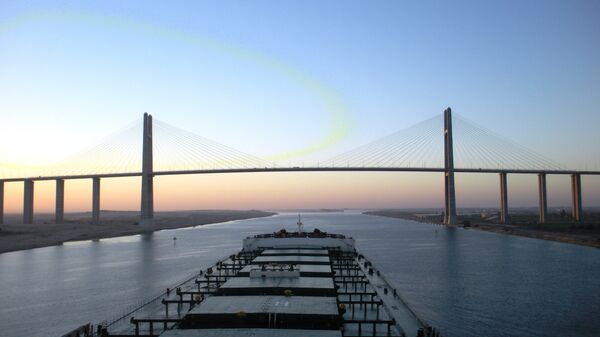MOSCOW, November 17 (Sputnik) – Shortening water-borne travel between the Atlantic and Indian oceans to approximately 6,500 kilometers, thereby avoiding the long and arduous route around Cape Horn at the southern tip of Africa, the Suez Canal Zone also acts as a trade boundary between Asia and Africa. The main seaports are Port Said at the northern terminus of the canal, and the city of Suez at the southern end, located at the top of the Gulf of Suez, a branch of the Red Sea. The canal passes through the lowest and narrowest section of the Isthmus of Suez, a 125 kilometer strip of land connecting Asia and Africa, crossing Lake Manzala, Lake Timsah and the Bitter Lakes regions.
The prospect of digging a canal through the Isthmus of Suez is not restricted to the modern era. Evidence suggests a navigable canal between the Nile River and the Red Sea existed circa 1,300 B.C., during the rule of Pharaohs Seti I and Ramesses II. Approximately 500 years later, Pharaoh Necho II, began an ambitious project to divert Nile waters into the 50-kilometer-long, now dry lakebed of Wadi Tumilat. This canal was never completed.
A thousand years later General Amr ibn al-As, who led a Muslim conquest of Egypt during the time of Muhammad, linked the Nile with the Red Sea to allow boats to carry wheat and other cargo. He called the canal "Halij Amir al-Muminin" ("Canal of the Ruler of the True Believers"). The canal fell into disuse after the 8th century.
In 1488, Portuguese nobleman and explorer Bartolomeu Dias successfully navigated the southernmost tip of Africa instantly negating the necessity of an overland spice trade at the Isthmus of Suez and into the Mediterranean, controlled by the Republic of Venice. Venetians, searching for a way to reestablish their hegemony, studied the possibility of building a canal from the Mediterranean Sea to the Gulf of Suez, but this project was never implemented.
By the early 19th century, Europeans traveling to India via Egypt sailed along the Nile to Cairo, where camel trains took them to the town of Suez.
The inaccurate calculations of Jacques-Marie Le Pére in 1798, a civil engineer ordered by Napoleon Bonaparte to complete a feasibility study for a canal, concluded erroneously the impracticability of linking the Red Sea and the Mediterranean due to incorrect water level readings.
The modern era of the Suez Canal began in 1854. Ferdinand de Lesseps, formerly the French consul in Egypt, obtained a concession from Sa'id Pasha, the administrative governor of Egypt and Sudan under the Ottoman Sultan, to allow the establishment of the Suez Canal Company. The company opened in 1858, with the governments of Egypt and France receiving 44 percent and 53 percent stakes, respectively. The remaining three percent went to other countries. Under the concession agreement, shareholders were entitled to 71% of profits. Egypt and the company's founders were eligible for approximately 15 percent and 10 percent of the profits, respectively.
Construction on the canal began in April 1859 and lasted for over 10 years, opening for commercial traffic November 17, 1869. Estimates figure that over 1.5 million laborers were involved in building the canal. An unknown number died during the work, mostly to disease. Overall cost was said to be double the original estimate.
In 1875, the British government purchased the Pasha's concession in the Suez Canal. France retained a majority. The Suez Canal Company by now had become a virtually British-French enterprise. In 1882, British forces occupied Egypt and the Suez Canal became the main British military and strategic base in the Middle East. The Convention of Constantinople, signed in 1888, mandated the Suez Canal as a neutral zone. This document remains in force today.
In 1956, British occupation forces departed the area and the Suez Canal was quickly nationalized by Egypt, leading to the Suez Crisis. The United Nations, led by Canadian Secretary of State for External Affairs Lester Pearson, negotiated a cessation of hostilities. As of present day a Multinational Force and Observers (MFO) peacekeeping force, stationed in the Sanai, is charged, in part, with policing the Suez Canal Zone and ensuring its neutrality.
The canal is 193.3 kilometers long and 24 meters deep. 205-225 meters wide at a depth of 11 meters, its cross-section area is 4,800-5,200 square meters. The canal can accept ships displacing up to 240,000 metric tons. Insignificant sea level fluctuations of approximately 65 centimeters in the north and 1.9 meters in the south do not affect the movement of ship traffic.
Built primarily for one-way traffic, the canal has two short parallel waterways in four sectors, allowing the passage of ships.
The Suez Canal handles about 10 percent of all international sea traffic, and an average of 49 ships transit the canal daily. Between January 1 and November 11, 2014, 14,807 ships traveled the Suez Canal.
In early August 2014, Egyptian authorities announced an ambitious project to increase the canal's capacity by building an expanded and modernized 70-kilometer section, anticipated to cost approximately $4 billion.


